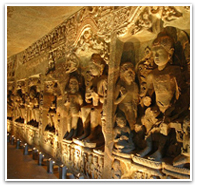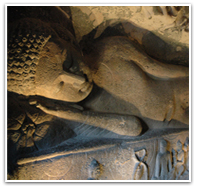“Don’t Tell me how educated you are, tell me how much you have traveled”, say the wise. Wisdom comes from experience; travel is the only thing you buy to make you richer! We are Prakriti Inbound, here to show you the World behind the obvious. Travel is about life, freedom and the joy of discovery, & we are committed in making your travel as you would want it. With us as your travel partner, you will always get “More World Per Mile.” Prakriti: Your World Travel Partner
Thursday, April 14, 2011
Scenic Tours in India
Tuesday, February 01, 2011
Ellora Caves
30 km away from Aurangabad in a small village of Verul, are the impressive Ellora caves. Intricately carved into the sides of a basaltic hill of the Sahyadri Mountain this world heritage site is one of the best examples of rock - cut caves in the whole world. It is the meeting point of three faiths, Buddhist, Jain and Hindu. There are 34 caves in all. 12 Buddhist (600 -800 A.D.), 17 Hindu (900A.D.) and 5 Jain caves (800 1000 A.D.).
The Buddhist caves from number 1 to 12, out of which ten belong to the Mahayana sect and two to the Hinayana sect of Buddhism. They all are viharas, Monasteries .Cave number 10 contains gigantic Buddha figure in meditation, seated on a lion throne, flanked by attendants and flying figures. Some caves have the story of the miracle of Sravasti when Buddha assumed thousand forms. The sculpture in the Buddhist caves accurately convey the nobility, grace and serenity inherent in the Buddha.
The Hindu caves starting from cave number 13 are mostly dedicated to Lord Shiva. These caves have intricate carvings with minute details of the ornaments and clothes on the idols. But cave number 16 takes the cake. The most famous of all the Ellora caves is the Kailash cave. It is dedicated to lord Shiva and has many stories depicting the life of Shiva and therefore it has assumed the name of Kailash, the abode of Shiva. A figure of goddess Lakshmi seated on a lotus flower in water is shown at the entrance. Before that figures of Ganesh and Durga can be seen. The cave has huge Shivalingam on the first floor.
This lavishly carved cave has been cut from one rock and is world's largest monolithic cave. Moreover this stupendous edifice, was begun from the top of the rock and worked slowly down to the floor, creating gateway, courtyard, pavilion vestibule and tower along the way with beautiful figures. There are figures of Dashavataras of Vishnu, and panels of stories from the great epics of Ramayana and Mahabharata. An important figure of Lanka King Ravana, trying to shake the Kailash, is seen along with various mythological stories related to the life of Shiva, including his wedding with Parvati and Ardha-nari-nateshwar, when Lord Shiva assumed the form of half man and half woman.
Ellora, chiefly patronized by the Chalukya - Rashtrakuta rulers (7th - 10th century AD) are the testimony to the skills and imagination who built them. It took nearly 150 years to complete the Kailash cave with nearly 7000 labourers working round the clock.
The Jain caves can be seen as the amalgamation of Buddhist and the Hindu caves. There are some intricate carvings and painted frescoes in these caves.
The famous magnificent Yakshi statue and ceiling paintings are in cave number 32.
Ghrishneshwar temple: Within five minutes driving distance from the Ellora caves is the ancient temple of Ghrishneshwar. A superb example of medieval temple architecture, it is dedicated to Lord Shiva and is considered to be one of the most important 12 Shivalingam temples, the Jyotirlingas, of India. It has intricate carvings on the exterior and was renovated by Rani Ahillyabai Holkar, of Indore in the 17th century.
The Buddhist caves from number 1 to 12, out of which ten belong to the Mahayana sect and two to the Hinayana sect of Buddhism. They all are viharas, Monasteries .Cave number 10 contains gigantic Buddha figure in meditation, seated on a lion throne, flanked by attendants and flying figures. Some caves have the story of the miracle of Sravasti when Buddha assumed thousand forms. The sculpture in the Buddhist caves accurately convey the nobility, grace and serenity inherent in the Buddha.
The Hindu caves starting from cave number 13 are mostly dedicated to Lord Shiva. These caves have intricate carvings with minute details of the ornaments and clothes on the idols. But cave number 16 takes the cake. The most famous of all the Ellora caves is the Kailash cave. It is dedicated to lord Shiva and has many stories depicting the life of Shiva and therefore it has assumed the name of Kailash, the abode of Shiva. A figure of goddess Lakshmi seated on a lotus flower in water is shown at the entrance. Before that figures of Ganesh and Durga can be seen. The cave has huge Shivalingam on the first floor.
This lavishly carved cave has been cut from one rock and is world's largest monolithic cave. Moreover this stupendous edifice, was begun from the top of the rock and worked slowly down to the floor, creating gateway, courtyard, pavilion vestibule and tower along the way with beautiful figures. There are figures of Dashavataras of Vishnu, and panels of stories from the great epics of Ramayana and Mahabharata. An important figure of Lanka King Ravana, trying to shake the Kailash, is seen along with various mythological stories related to the life of Shiva, including his wedding with Parvati and Ardha-nari-nateshwar, when Lord Shiva assumed the form of half man and half woman.
Ellora, chiefly patronized by the Chalukya - Rashtrakuta rulers (7th - 10th century AD) are the testimony to the skills and imagination who built them. It took nearly 150 years to complete the Kailash cave with nearly 7000 labourers working round the clock.
The Jain caves can be seen as the amalgamation of Buddhist and the Hindu caves. There are some intricate carvings and painted frescoes in these caves.
The famous magnificent Yakshi statue and ceiling paintings are in cave number 32.
Ghrishneshwar temple: Within five minutes driving distance from the Ellora caves is the ancient temple of Ghrishneshwar. A superb example of medieval temple architecture, it is dedicated to Lord Shiva and is considered to be one of the most important 12 Shivalingam temples, the Jyotirlingas, of India. It has intricate carvings on the exterior and was renovated by Rani Ahillyabai Holkar, of Indore in the 17th century.
Monday, January 24, 2011
Ajanta Caves
A two and half hour drive from Aurangabad takes you to the world heritage site of Ajanta. Although it is nearer to the cities of Jalgaon and Buldhana, Ajanta caves are better approached from Aurangabad. The caves are built in a horseshoe shaped curve of the steep rocky gorge that rises above the river Waghore. These rock hew caves, still glowing in their own natural colors, are the finest achievements of the Buddhist monks who arrived here in 2nd century B.C. and reflect the zenith of ancient Indian art and architecture. Though most were carved in the first 400 years span, but the work continued till 7th century A.D. The caves were suddenly abandoned, most probably to the nearby Ellora caves. They remained unknown and forgotten for centuries, until, in 1819, soldiers from a British hunting party found them, accidentally.
The exquisite paintings on the walls of the caves and some sculptures depict the development in Buddhism, over the span of eight centuries. The central theme of the frescoes remain the life and times of Buddha. Then there are descriptive Jataka tales, when Buddha assumed forms of animals on the earth in his previous births. There are lions, elephants, monkeys, peacocks and geese with human forms of 'Yakshas', 'Kinneras' (half human and half bird) 'Gandharvas' (divine musicians), 'Apsaras' (heavenly dancers), which were of concern to the people of that time. All of them decorated with intricacy. Their half-closed eyes giving an air of meditation.
The most important and better preserved caves are cave numbers 1, 2, 16, 17 and 19.
Cave 1:
The exquisite paintings on the walls of the caves and some sculptures depict the development in Buddhism, over the span of eight centuries. The central theme of the frescoes remain the life and times of Buddha. Then there are descriptive Jataka tales, when Buddha assumed forms of animals on the earth in his previous births. There are lions, elephants, monkeys, peacocks and geese with human forms of 'Yakshas', 'Kinneras' (half human and half bird) 'Gandharvas' (divine musicians), 'Apsaras' (heavenly dancers), which were of concern to the people of that time. All of them decorated with intricacy. Their half-closed eyes giving an air of meditation.
The most important and better preserved caves are cave numbers 1, 2, 16, 17 and 19.
Cave 1:
The doorway has the most seen Ajanta frescoes of Padmapani and Vajrapani; celestial figures holding Lotus and Thunder bolt respectively in their hands. A court scene, from the Mahajanaka Jataka is depicted here. The Ummaga Jataka and the Champeya Jataka are shown in this cave. Interesting in these frescoes is the head gear of Bodhisattva Avalokiteshwara and the ornaments, clothes hairstyles and the purses carried by the womenfolk. They are drawn and coloured with minute intricacy showing the caliber of the artisans.
Cave 2:
In cave number 2 Buddhist icons were sculpted according to a set of codified rules that used symbolic hand gestures and motifs such as the wheel, the deer, the throne and sacred Bodhi tree. Each represents a stage of Buddha's life. The ceiling and wall paintings illustrate events associated with Buddha's birth including Maya, Buddha's mother. There are many paintings in this cave where the human figures are dressed differently than those of the others. Others are the tales from the Vidhurpandita Jataka.
Cave 16:
In between cave number 2 and 16 are many caves depicting the miracle of Sravasti. A special painting known as the "dying princess" adorns one wall of the cave. This shows Sundari, the wife of Buddha's half-brother, dying when she is told that her husband was going to become a monk. There are many female attendants besides her, one being a nurse. Astonishingly enough, the nurse is shown wearing the same uniform as of today.
Cave 17:
Stories from the Vishvantara Jataka and the Hamsa Jataka can be found here. One fresco shows Buddha preaching, with his right hand raised and palm facing the viewer, in posture of blessing. Buddha is shown seated in Padmasana- the lotus pose of meditation and is often shown with his hair tied in a topknot surrounded by a halo of light, representing nirvana or enlightenment. Another touching fresco is depicted in this cave when Buddha came back to Kapilavastu after enlightenment. He is shown with his wife Yashodhara and son Rahul. Here the figure of Buddha is tall and his wife and son look like dwarfs in from him, depicting his knowledge and prominence.
Cave 19:
Just like the caves in Ellora, all the caves in Ajanta are Monolithic and carved from top to bottom. This cave carries huge Stupa structure with Buddha seated in it and celestial figures flying over it.
Cave 26:
Last of the caves which is intricately decorated and carved. The main sculpture here is that of the sleeping Buddha. It is the legend of his Mahanirvana; i.e. his death. While normal humans are seen mourning below, the celestial figures in the heaven are seen rejoicing.
Ajanta is being restored with the same natural colours that were used, where they have been faded.
Ajanta is being restored with the same natural colours that were used, where they have been faded.
Subscribe to:
Posts (Atom)



